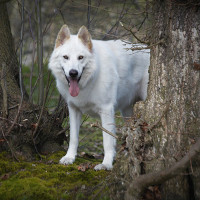Appearance of the Northern Inuit Dog
|
| Northern Inuit Dogs are a large breed, measuring up to 81 centimeters and weighing over 45 kilos. They are built with a slim, slender frame that still possesses a good amount of muscle, but not to the point of being uncluttered or bulky. As elsewhere, their face resembles that of a wolf, with a relatively neat width of skull, widened in appearance by extra hair and a long, narrow muzzle topped by a black nose. Their ears are large and erect, and their eyes are oval and of all colors. They have relatively long legs, deep but somewhat narrow chests, straight backs slightly curved over the hindquarters and well-muscled legs, especially at the rear. Their tails are long and bushy with a good amount of hair and are generally unkempt. Their coats are very similar to those of wolves, relatively long and dense with a thicker, softer undercoat, and available in a wide variety of colors, including pure black, pure white, gray, sable and fawn. |
Temperament of the Northern Inuit Dog
|
| Northern Inuit Dogs are affectionate, friendly dogs and enjoy being part of a family or pack, although they tend to develop separation anxiety if left alone for too long. They have been described as lively and mischievous, which can be fun when incorporated into positive behavior, but with potential separation anxiety can also lead them to become destructive. They are considered inherently good with people, being patient with children and very serene with family, but especially with strangers, can become aloof if uncomfortable. They're a highly intelligent breed, which makes them very responsive once they've been trained, but the training process itself can be an uphill battle, as they still retain the strong-willed nature of their ancestors, so they'll need a firm, consistent owner to give them commands to get the best behavior out of them. Since their exercise requirements are generally not as high as those of other dogs of similar size, it's easier to tire them out and thus generate more good behavior instead of what most owners see when their dogs have built up energy. This also makes them a little more adaptable than other large dogs, which means they'll be better suited to smaller living spaces provided they have a semi-active owner or family. |
Needs and activities of the Northern Inuit Dog
|
| Unlike many other dogs of their size, Northern Inuit Dogs do not require an excessive amount of exercise and are generally considered to be medium-strength dogs. While they appreciate a place to run, such as a large fenced yard or dog park, they will be content with two medium walks or runs, or one longer walk or run, supplemented by about 45 minutes of recreation. Because of their high intelligence, playing games that stimulate them mentally and physically will go a long way to promoting positive behavior. |
Maintenance of the Northern Inuit Dog
|
| Although they have longer coats and are moderately shedding, Northern Inuit Dogs are considered a low-maintenance breed. They only need to be brushed 2-3 times a week with a smooth brush and desiccant to keep their undercoat clean and healthy. They keep themselves clean on a regular basis and rarely need a bath, unless they smell bad. If exercised regularly, their nails should mainly wear themselves out, but should nevertheless be checked frequently and trimmed as necessary to avoid cracks and breaks. Their teeth should also be brushed at least once a week to maintain good oral health. |







 English (United Kingdom)
English (United Kingdom)